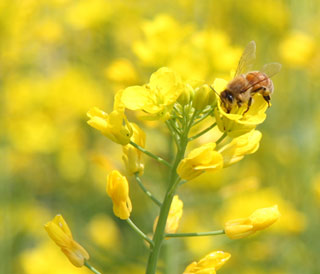Study says insecticide used with GM corn highly toxic to bees
By Ken Roseboro
Published: February 1, 2012
Category: GM Food Environmental Risks

To access all the articles in this month's issue of The Organic & Non-GMO Report, SUBSCRIBE NOW.
Sierra Club, US bee and honey groups urge EPA to ban clothianidin
An insecticide used as a seed treatment on genetically modified corn and other crops has been found to be highly toxic to honey bees, according to a study published recently in the journal PLoS ONE.
The study may be a key to solving the mystery of Colony Collapse Disorder that has decimated bee populations over the last five years, causing losses of 30% and more of honey bee colonies every year since 2006, according to the US Department of Agriculture.
Found at levels 700,000 times a bee’s lethal dosage
Scientists at Purdue University documented major adverse impacts from the insecticide clothianidin (product name “Poncho”) on honey bee health. The study found that bees are exposed to clothianidin and other pesticides throughout the foraging period. Researchers found extremely high levels of clothianidin—as high as 700,000 times a bee’s lethal dosage—in seed planter exhaust material. It was found in foraging areas long after treated seed had been planted and in dead bees near hives in Indiana. It was also found in pollen collected by bees and stored in the hive. The study raises questions about the long-term survival of this major pollinator.
“This research should nail the coffin lid shut on clothianidin,” says Laurel Hopwood, Sierra Club’s chairwoman of the Genetic Engineering Action Team. “Despite numerous attempts by the beekeeping industry and conservation organizations to persuade the EPA to ban clothianidin, the EPA has failed to protect the food supply for the American people.”
“Clothianidin is among those most toxic to bees”
Clothianidin, which is manufactured by German agricultural company Bayer Crop Science, is of the neonicotinoid family of systemic pesticides. Clothianidin is taken up by a plant’s vascular system and expressed through pollen and nectar from which bees then forage and drink. Neonicotinoids are of particular concern because they have cumulative, sublethal effects on insect pollinators that correspond to Colony Collapse Disorder symptoms—namely, neurobehavioral and immune system disruptions.
According to James Frazier, Ph.D., professor of entomology at Penn State’s College of Agricultural Sciences, “Among the neonicotinoids, clothianidin is among those most toxic for honey bees; and this combined with its systemic movement in plants has produced a troubling mix of scientific results pointing to its potential risk for honey bees through current agricultural practices.”
Clothianidin has been widely used as a seed treatment on many of the country’s major crops, particularly GM corn, since 2003. Back then, the Environmental Protection Agency granted it a “conditional registration,” while EPA waited for Bayer to conduct a field study assessing the insecticide’s threat to bee colony health.
“Continued use is in violation of the law”
Bayer submitted its study to the EPA in 2007, two years after it was due. A memo written by EPA scientists and leaked in 2010 said that Bayer’s study was flawed, stating that “deficiencies were identified that render the study supplemental.”
The memo was found by Tom Theobald, a founding member of the Boulder County Beekeeper’s Association. “The document reveals that the agency has been allowing the widespread use of this bee-toxic pesticide, against evidence that it’s highly toxic to bees. Clothianidin has failed to meet the requirements for registration. Its continued use is in violation of the law,” Theobald says.
Upon learning of the EPA’s failures, the National Honey Bee Advisory Board, the American Beekeeping Federation, and the American Honey Producer’s Association urged the agency in a December 2010 letter to cancel the registration of this pesticide. Yet despite the fact that clothianidin had failed a critical life cycle study which was required for registration, the agency responded in a February 2011 letter stating that it wasn’t “aware of any data that reasonably demonstrates that bee colonies are subject to elevated losses due to chronic exposure to this pesticide” and “does not intend to initiate suspension or cancellation actions against the registered uses of clothianidin.”
“Time for EPA to cancel this bee-killing pesticide”
Now with the published study documenting harm to bees from clothianidin, beekeepers, honey producers, and environmental groups are calling on the EPA again to ban it.
“EPA said we don’t have the science (to ban clothianidin). Now we have the science,” Theobald says.
Neil Carman, Ph.D., scientific advisor to Sierra Club, says: “A huge shoe has dropped. US researchers have documented major adverse impacts from clothianidin seed treatments in corn on honey bee health.” Carman further explains “Because of the vital role played by honey bees in crop pollination, honey bee demise threatens the production of crops that produce one-third of American diets, including nearly 100 fruits and vegetables. The value of crops pollinated by bees exceeds $15 billion in the US alone.”
Hopwood exclaims, “The time is now for EPA to quit dodging the illusion of oversight and instead, cancel this bee-killing pesticide. If we travel too far down our current path, we could create conditions in our food system much like those that brought down the financial system.”
© Copyright The Organic & Non-GMO Report, February 2012




